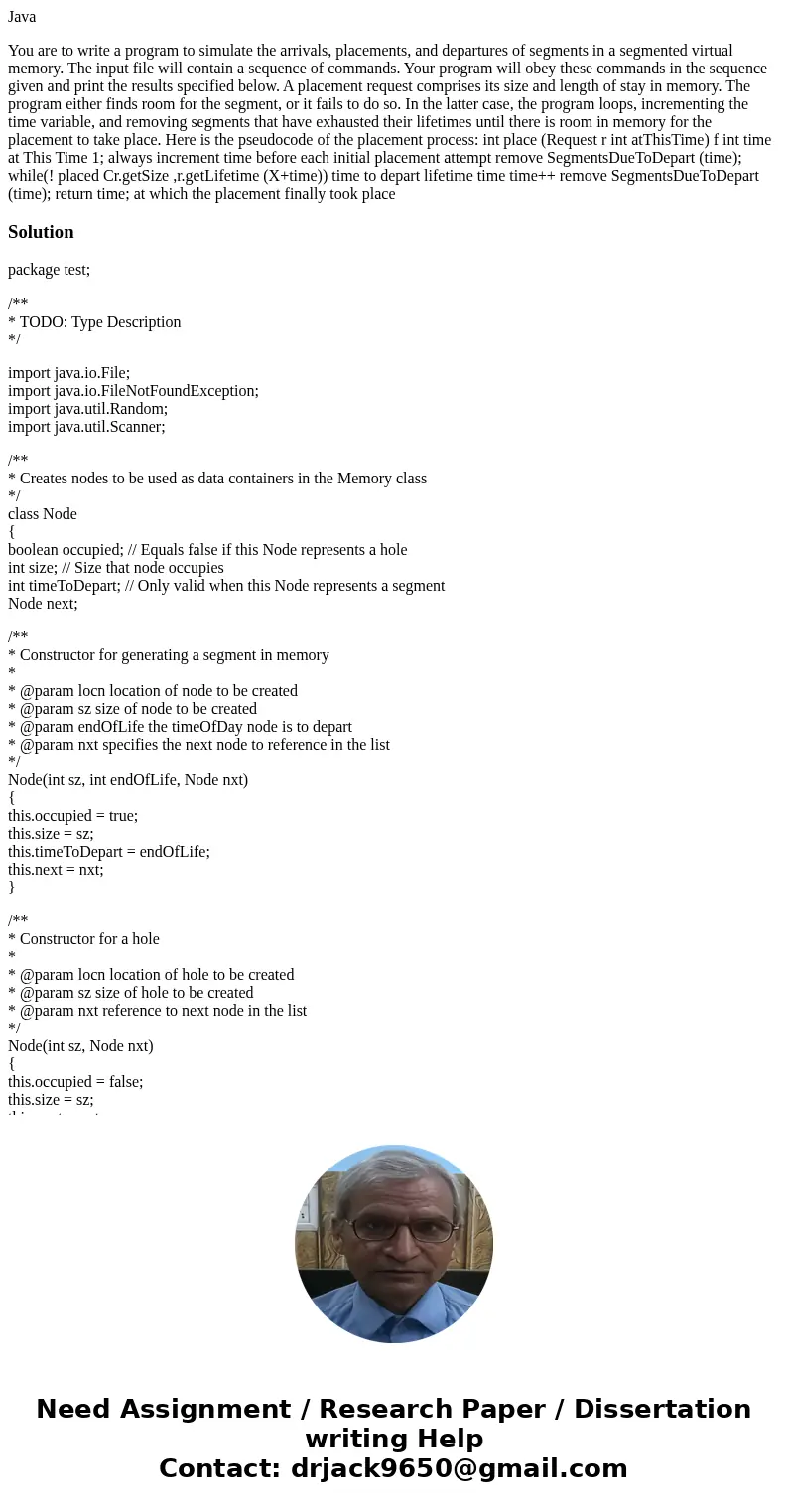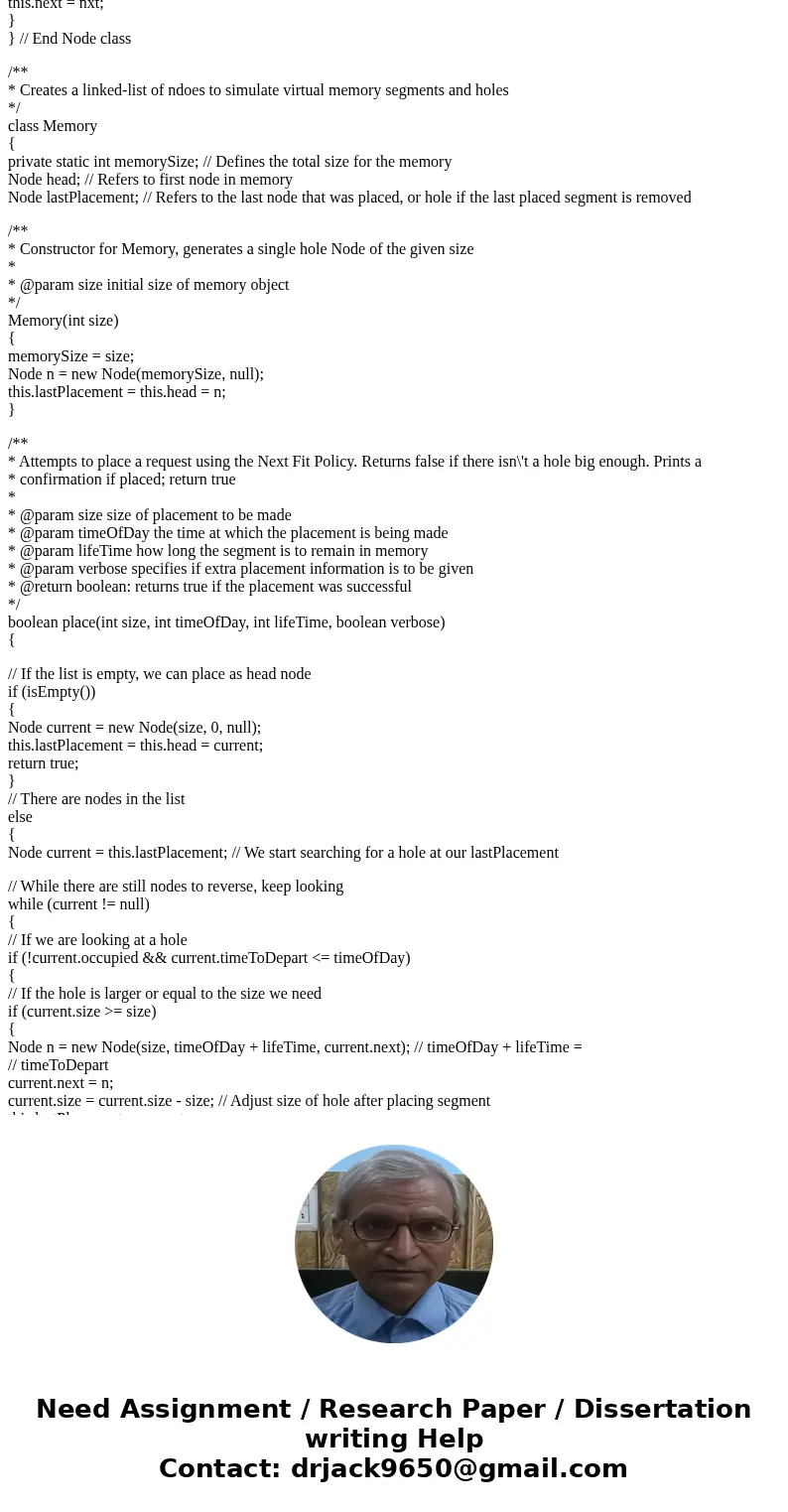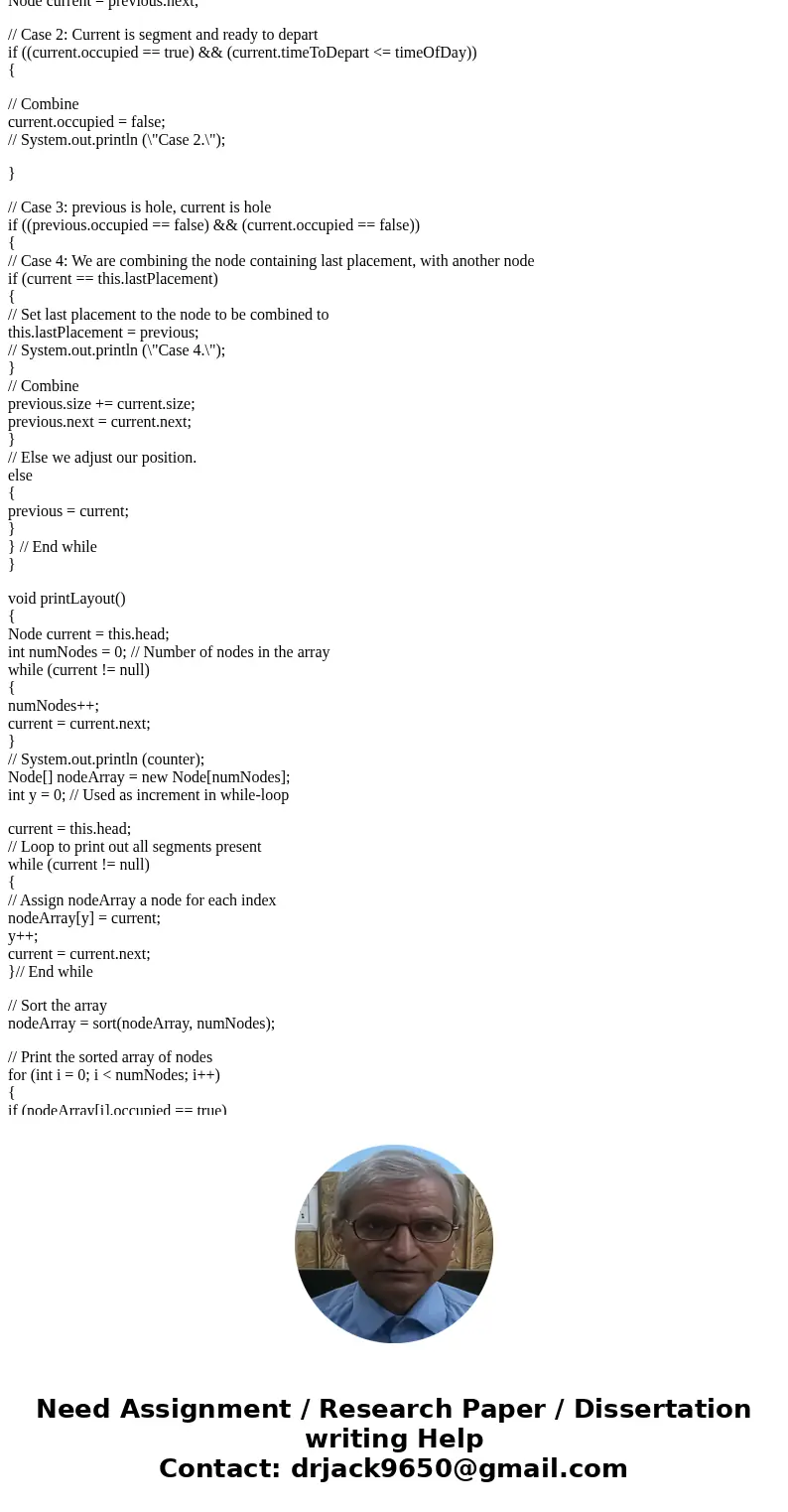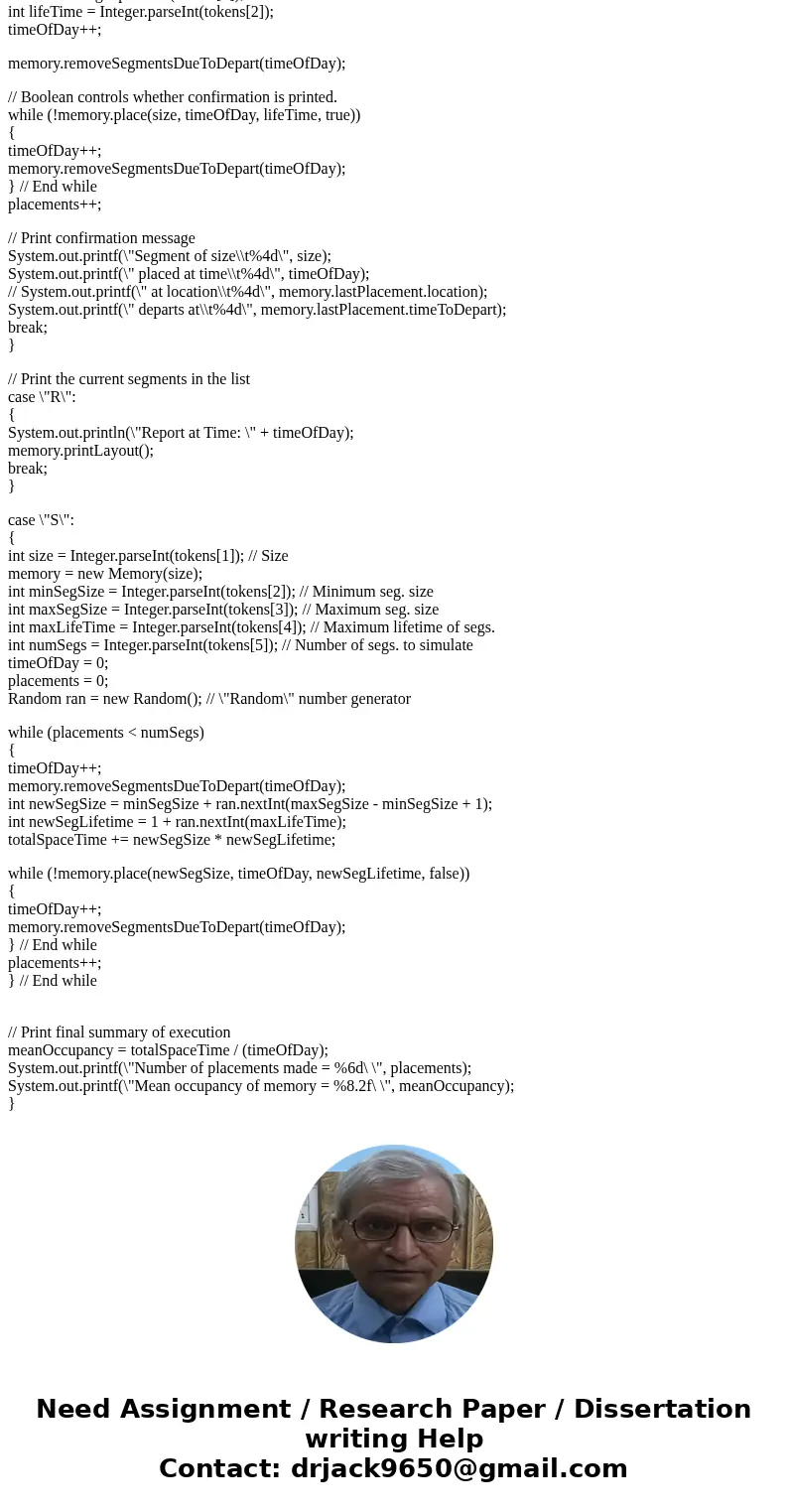Java You are to write a program to simulate the arrivals pla
Java
You are to write a program to simulate the arrivals, placements, and departures of segments in a segmented virtual memory. The input file will contain a sequence of commands. Your program will obey these commands in the sequence given and print the results specified below. A placement request comprises its size and length of stay in memory. The program either finds room for the segment, or it fails to do so. In the latter case, the program loops, incrementing the time variable, and removing segments that have exhausted their lifetimes until there is room in memory for the placement to take place. Here is the pseudocode of the placement process: int place (Request r int atThisTime) f int time at This Time 1; always increment time before each initial placement attempt remove SegmentsDueToDepart (time); while(! placed Cr.getSize ,r.getLifetime (X+time)) time to depart lifetime time time++ remove SegmentsDueToDepart (time); return time; at which the placement finally took placeSolution
package test;
/**
* TODO: Type Description
*/
import java.io.File;
import java.io.FileNotFoundException;
import java.util.Random;
import java.util.Scanner;
/**
* Creates nodes to be used as data containers in the Memory class
*/
class Node
{
boolean occupied; // Equals false if this Node represents a hole
int size; // Size that node occupies
int timeToDepart; // Only valid when this Node represents a segment
Node next;
/**
* Constructor for generating a segment in memory
*
* @param locn location of node to be created
* @param sz size of node to be created
* @param endOfLife the timeOfDay node is to depart
* @param nxt specifies the next node to reference in the list
*/
Node(int sz, int endOfLife, Node nxt)
{
this.occupied = true;
this.size = sz;
this.timeToDepart = endOfLife;
this.next = nxt;
}
/**
* Constructor for a hole
*
* @param locn location of hole to be created
* @param sz size of hole to be created
* @param nxt reference to next node in the list
*/
Node(int sz, Node nxt)
{
this.occupied = false;
this.size = sz;
this.next = nxt;
}
} // End Node class
/**
* Creates a linked-list of ndoes to simulate virtual memory segments and holes
*/
class Memory
{
private static int memorySize; // Defines the total size for the memory
Node head; // Refers to first node in memory
Node lastPlacement; // Refers to the last node that was placed, or hole if the last placed segment is removed
/**
* Constructor for Memory, generates a single hole Node of the given size
*
* @param size initial size of memory object
*/
Memory(int size)
{
memorySize = size;
Node n = new Node(memorySize, null);
this.lastPlacement = this.head = n;
}
/**
* Attempts to place a request using the Next Fit Policy. Returns false if there isn\'t a hole big enough. Prints a
* confirmation if placed; return true
*
* @param size size of placement to be made
* @param timeOfDay the time at which the placement is being made
* @param lifeTime how long the segment is to remain in memory
* @param verbose specifies if extra placement information is to be given
* @return boolean: returns true if the placement was successful
*/
boolean place(int size, int timeOfDay, int lifeTime, boolean verbose)
{
// If the list is empty, we can place as head node
if (isEmpty())
{
Node current = new Node(size, 0, null);
this.lastPlacement = this.head = current;
return true;
}
// There are nodes in the list
else
{
Node current = this.lastPlacement; // We start searching for a hole at our lastPlacement
// While there are still nodes to reverse, keep looking
while (current != null)
{
// If we are looking at a hole
if (!current.occupied && current.timeToDepart <= timeOfDay)
{
// If the hole is larger or equal to the size we need
if (current.size >= size)
{
Node n = new Node(size, timeOfDay + lifeTime, current.next); // timeOfDay + lifeTime =
// timeToDepart
current.next = n;
current.size = current.size - size; // Adjust size of hole after placing segment
this.lastPlacement = current = n;
return true;
}
}
current = current.next;
} // End while
current = this.head; // To traverse from start of list
// While there are still nodes to reverse, keep looking
while (current != this.lastPlacement)
{
// If we are looking at a hole
if (!current.occupied && current.timeToDepart <= timeOfDay)
{
// If the hole is larger or equal to the size we need
if (current.size >= size)
{
Node n = new Node(size, timeOfDay + lifeTime, current.next); // timeOfDay + lifeTime =
// timeToDepart
current.next = n;
current.size = current.size - size;
this.lastPlacement = current = n;
return true;
}
}
current = current.next;
} // End while
}
// If we reach this point, segment could not be placed
return false;
}
/**
* Remove segments from the list, which are ready to depart.
* <p>
* Checks the following conditions:
* <ul>
* <li>1) Head is segment and ready to depart 2) Current is segment and ready to depart 3) Previous is hole, current
* is hole 4) We are combining the node containing last placement, with another node</li>
* </ul>
* </p>
*
* @param timeOfDay time at which the removal is being done
*/
void removeSegmentsDueToDepart(int timeOfDay)
{
// Case 1: Head is segment and ready to depart
if ((this.head.occupied == true) && (this.head.timeToDepart <= timeOfDay))
{
this.head.occupied = false; // Allow node to become a hole
// System.out.println (\"Case 1.\");
}
// Create reference to head node
Node previous = this.head;
// Begin iterating on list from 2nd node
while (previous.next != null)
{
// Use this as our current position
Node current = previous.next;
// Case 2: Current is segment and ready to depart
if ((current.occupied == true) && (current.timeToDepart <= timeOfDay))
{
// Combine
current.occupied = false;
// System.out.println (\"Case 2.\");
}
// Case 3: previous is hole, current is hole
if ((previous.occupied == false) && (current.occupied == false))
{
// Case 4: We are combining the node containing last placement, with another node
if (current == this.lastPlacement)
{
// Set last placement to the node to be combined to
this.lastPlacement = previous;
// System.out.println (\"Case 4.\");
}
// Combine
previous.size += current.size;
previous.next = current.next;
}
// Else we adjust our position.
else
{
previous = current;
}
} // End while
}
void printLayout()
{
Node current = this.head;
int numNodes = 0; // Number of nodes in the array
while (current != null)
{
numNodes++;
current = current.next;
}
// System.out.println (counter);
Node[] nodeArray = new Node[numNodes];
int y = 0; // Used as increment in while-loop
current = this.head;
// Loop to print out all segments present
while (current != null)
{
// Assign nodeArray a node for each index
nodeArray[y] = current;
y++;
current = current.next;
}// End while
// Sort the array
nodeArray = sort(nodeArray, numNodes);
// Print the sorted array of nodes
for (int i = 0; i < numNodes; i++)
{
if (nodeArray[i].occupied == true)
{
System.out.println(\"segment \" + nodeArray[i].size + \"\\t\" + nodeArray[i].timeToDepart);
}
else
{
System.out.println(\"hole \" + nodeArray[i].size + \"\\t\");
}
}
}
/**
* Use a bubble sort to sort the node array by location in ascending order
*
* @param node Node array that contains the nodes to be sorted in ascending order
* @param length How many nodes there are to be sorted
* @return Node[] Returns sorted Node array.
*/
Node[] sort(Node[] node, int length)
{
Node tempNode;
for (int i = 0; i < (length - 1); i++)
{
for (int j = 0; j < length - i - 1; j++)
{
// Sort the array by location in ascending order
if (node[j].size > node[j + 1].size)
{
tempNode = node[j];
node[j] = node[j + 1];
node[j + 1] = tempNode;
}
}
}
return node;
}
/**
* Determines the empty or occupied state of the list
*
* @return Returns true if list is empty
* @return Returns false if nodes are in the list
*/
public boolean isEmpty()
{
if (this.head == null)
{
return true;
}
return false;
}
} // End Memory class
/**
* Class to test Memory and Node classes. Accepts file-redirection from commandline by using the scanner with System.in,
* can also accept file input by using scanner with new File
*/
public class EVBEP1
{
/**
* Used to test implementation of Memory and Node objects. Processes commands received through either the
* commandline or file-input.
*
* @param args Standard parameter for parsing commands received
* @throws FileNotFoundException If file is unable to be located, exception is thrown
*/
public static void main(String[] args)
throws FileNotFoundException
{
// Used for accepting command line arguments
// Scanner sc = new Scanner (System.in);
// Used for testing purposes
Scanner sc = new Scanner(new File(\"D:/Selenium/WS17.0/test/src/test/file.txt\")); // Place file name here for
// different tests
String line = \"\";
boolean done = false;
Memory memory = new Memory(0); // Memory object
int timeOfDay = 0; // Simulated wall clock, begins with value zero
int placements = 0; // Number of placements completed, begins with value zero
long totalSpaceTime = 0; // Sum of placed segmentSize(i) x segmentLifetime(i)
float meanOccupancy = 0;
// Loop runs as long as done != true
while (!done)
{
line = sc.nextLine(); // Store data gathered from file into String
String[] tokens = line.split(\" \"); // Split the string using space as delimiter
// Switch for processing commands received
switch (tokens[0])
{
// Print name followed by newline
case \"FF\":
{
System.out.println(\"FIRST FIT\");
break;
}
case \"BF\":
{
System.out.println(\"BEST FIT\");
break;
}
// Create a memory object of size s
case \"C\":
{
memory = new Memory(Integer.parseInt(tokens[1])); // Create a new Memory object
break;
}
// End of data file, print newline and exit
case \"E\":
{
System.out.println();
done = true; // Break the loop, end the program
break;
}
// Add segment of size \'u\' and lifetime \'v\' and print confirmation record
case \"P\":
{
int size = Integer.parseInt(tokens[1]);
int lifeTime = Integer.parseInt(tokens[2]);
timeOfDay++;
memory.removeSegmentsDueToDepart(timeOfDay);
// Boolean controls whether confirmation is printed.
while (!memory.place(size, timeOfDay, lifeTime, true))
{
timeOfDay++;
memory.removeSegmentsDueToDepart(timeOfDay);
} // End while
placements++;
// Print confirmation message
System.out.printf(\"Segment of size\\t%4d\", size);
System.out.printf(\" placed at time\\t%4d\", timeOfDay);
// System.out.printf(\" at location\\t%4d\", memory.lastPlacement.location);
System.out.printf(\" departs at\\t%4d\", memory.lastPlacement.timeToDepart);
break;
}
// Print the current segments in the list
case \"R\":
{
System.out.println(\"Report at Time: \" + timeOfDay);
memory.printLayout();
break;
}
case \"S\":
{
int size = Integer.parseInt(tokens[1]); // Size
memory = new Memory(size);
int minSegSize = Integer.parseInt(tokens[2]); // Minimum seg. size
int maxSegSize = Integer.parseInt(tokens[3]); // Maximum seg. size
int maxLifeTime = Integer.parseInt(tokens[4]); // Maximum lifetime of segs.
int numSegs = Integer.parseInt(tokens[5]); // Number of segs. to simulate
timeOfDay = 0;
placements = 0;
Random ran = new Random(); // \"Random\" number generator
while (placements < numSegs)
{
timeOfDay++;
memory.removeSegmentsDueToDepart(timeOfDay);
int newSegSize = minSegSize + ran.nextInt(maxSegSize - minSegSize + 1);
int newSegLifetime = 1 + ran.nextInt(maxLifeTime);
totalSpaceTime += newSegSize * newSegLifetime;
while (!memory.place(newSegSize, timeOfDay, newSegLifetime, false))
{
timeOfDay++;
memory.removeSegmentsDueToDepart(timeOfDay);
} // End while
placements++;
} // End while
// Print final summary of execution
meanOccupancy = totalSpaceTime / (timeOfDay);
System.out.printf(\"Number of placements made = %6d\ \", placements);
System.out.printf(\"Mean occupancy of memory = %8.2f\ \", meanOccupancy);
}
} // End switch
} // End while
sc.close();
} // End main
} // End EVBEP1 class








 Homework Sourse
Homework Sourse